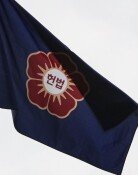Buddhist painting repatriated from Japan was drawn in width
Buddhist painting repatriated from Japan was drawn in width
Posted December. 03, 2013 09:36,
"Ssanglim Nirvana," a Buddhist painting that was created in Joseon Dynasty and was repatriated to Korea from Japan in July this year was confirmed to be the oldest Buddhist painting drawn in width found so far.
Art History Professor Chung Woo-taek at Dongkuk University said at the Dongak Art History society held in National Muesum of Korea on Saturday, "After appraisal from demand by Dongkuk Temple in North Jeolla Province that purchased the religious painting, it was found that the painting comes from early Joseon Dynasty period in mid-16th century, ahead of the Buddha Birth painting (1692 product) of the same dynasty owned by Kejo, Japan, that was drawn in width." There are some 160 Buddha paintings of Korea and Joseon dynasties confirmed so far. Most of them are drawn in height and only two, including the Ssanglim Nirvana, take a wide-long form.
Ssanglim Nirvana, 224.5×87.0cm, displays Buddha reaching nirvana in the forest of four pairs of sal trees. It took the form of the final nirvana painting contained on the Seokgapalsangdo listed in the Seokbosangieol (Treasure No. 523). Professor Chung said, "The dual coloring using dyes and gold dust is similar to the Sakamuni Sermon Paintings of 1953 and Samjangbosaldo of 1568," adding, "The clothing of the monk in the painting and looks realized well the Joseon Dynasty style."
The painting has important value in that it was painted in dual colors found only in Goryeo Dynasty Buddhist paintings and thus is first proof of the Buddhist painting techniques succeeded from Goryeo Dynasty to Joseon Dynasty. Dual coloring is to repeatedly paint on the back of silk or hemp cloth and not color on the front, to display natural texture. Chung Eun-woo, head of Seokdang Museum at Donga University, said, "This is a masterpiece that shows a totally different coloring and style than the 17th century Joseon Dynasty Buddhist paintings."
The painting itself is also a breakaway from existing style. The scene of the ritual of collecting the remains after cremation that is shown on the left side of the painting emerges on most of nirvana paintings. But the scenery of putting in small crystals (found among cremated remains of monks) into the straw rice-bag and carrying them in bundle is nowhere seen in Chinese and Japanese Buddhist paintings. Emeritus Professor Kim Ri-na at Hongik University said, "This is an extraordinary Buddhist painting that resisted standardization."
Headline News
- Med professors announce intention to leave hospitals starting Thursday
- Bridge honoring Sgt. Moon Jae-sik unveiled in Pennsylvania
- Chief of Staff Chung tells presidential secretaries to stay away from politics
- US FTC bans noncompete agreements
- N. Korea launches cyberattacks on S. Korea's defense companies







